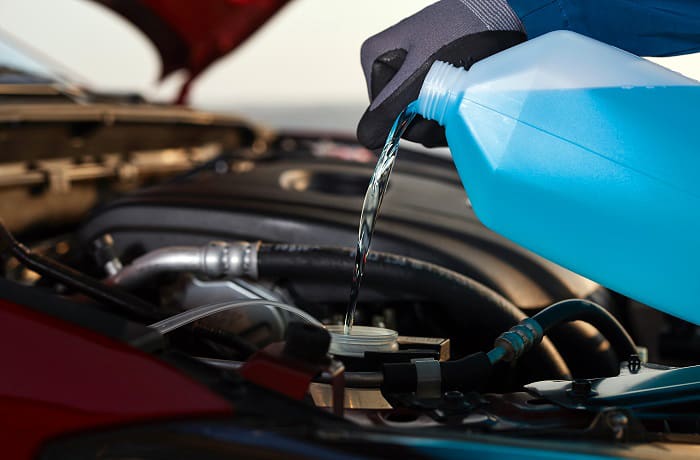This depends on the paint on your car. Antifreeze won’t damage the paint in most modern cars. The much it can do is leave behind a stain that can be easily washed off with water.
However, for cars with old paint such as the ones made in the ’80s or ’90s, the glycol found in antifreeze can damage the car paint.
It is therefore very important to keep antifreeze away from the paint job of an antique because the results can be catastrophic.
We can also say the same for new paint jobs. As we will explain later on, antifreeze is explicitly made for the engine.
Should you accidentally spill some on your car paint, wash the area with soap and rinse it off with water as soon as you realize this has happened.
Your car’s clear coat is vulnerable to ingredients such as propylene glycol which is found in antifreeze and you should avoid, by all means, getting it on your car paint.

How Soon Should You Clean Antifreeze from Car Paint?
Should your radiator hose blow accidentally, and the antifreeze spill on your paint. Or, if antifreeze just finds its way onto your car paint, you may be wondering, how soon should I remove it from the car paint?
The first thing you need to do is attend to more serious matters such as a blown radiator hose. When that is done, you should clean the antifreeze from your car paint.
As mentioned earlier, the antifreeze won’t hurt your car paint right away. But it’s very important to be cautious especially if you have a new car.
If you often wax your car, antifreeze residue shouldn’t be your biggest concern because both your car paint and clear coat will be protected.
However, if you don’t wax your car, it’s a good idea to pour some water on the antifreeze residue so it is diluted and loses its strength.
As a car owner, you need to evaluate the best decision that suits your exact condition. If your car isn’t waxed, you should rinse it off right away. And if antifreeze spills on an antique, action needs to be taken right away.
How Do I Remove Antifreeze Residue From Car Paint?
If you have just spilled antifreeze on your car paint, you may be stuck wondering what the best course of action to take is.
Should you give it a quick rinse? Or should you opt for some car wash shampoo? What about a strong stain remover like isopropyl alcohol?
In the past, we have written several articles advising our readers on which are the best cleaning agents to use on cars. And if you have read our articles, then you know our stand on using isopropyl alcohol on car paint.
The latter etches paint when used for a long period. And antifreeze doesn’t leave the kind of stain that deserves a strong cleaning agent.
When it comes to removing antifreeze residue from car paint, just go about how you would normally wash your car paint.
Use your preferred car wash shampoo and don’t over-scrub as there may be dust particles that can scratch your car. Rinse it with some water and your paint will be safe.
Unlike brake fluid, antifreeze isn’t a big menace to car paint. Provided you have some soap and water, it should rinse effortlessly.
For antifreeze that has already dried on car paint, rinse it with water fast so that it can loosen up before being washed with shampoo.
Also, note that water alone can’t remove antifreeze residue. Some marring may be left behind, so please use soap.
Once you are done cleaning it, don’t forget to re-wax the area. Depending on how long the antifreeze was on the car paint, it may have stripped some wax.
It is, therefore, a good idea to re-wax the area so that you can enhance your car’s protection.
What Happens When Antifreeze Dries on Car Paint?
Never let a foreign compound dry on your car paint. The reason is, that it will either stick to your paint, leave a stain, or it may eat through your car’s clear coat.
It’s not always when you may be in a scenario where you can wash the antifreeze residue right away and wax it. So, you may be wondering, what will happen when you let antifreeze dry on car paint?
The first thing that will happen is that it will leave a visible stain. And as you already know, stains require thorough cleaning to be removed.
Even if antifreeze dries on car paint, you can rest assured that it won’t eat through car paint right away. So, you have a lot of room for how long you can take to clean it off.
With the above in mind, when you finally get home and decide to remove the dried antifreeze residue, soak it with some water so that the solution loosens up.
Grab your favorite car wash shampoo, scrub it gently, and then rinse it off with water. That should be enough to remove antifreeze on car paint.
If you can still see the stain, grab a clay bar and clay in that particular area. Or if you have the time, clay the entire car.
Claying is one of the proven ways you can get rid of impurities such as antifreeze on your car paint.
Does It Matter If the Antifreeze is Hot?
If the antifreeze is straight from the radiator, there is a huge chance that it will be mixed with hot water. As a concerned car owner, you may be worried if the hotness of the antifreeze will contribute to damaging car paint.
In the same way, human beings hate cold showers so do cars. Hot water can be used safely in washing cars provided it isn’t too hot to burn your hands.
When water is hot, it absorbs more impurities on car paint and gives your car a thorough cleanse.
So, if the antifreeze is coming directly from the radiator, you need not worry about it damaging your car paint. Treat it as you would when washing other impurities off your car.
What is Antifreeze Made Up Of?
To fully understand the effects of antifreeze on car paint, we must look at what it’s made of.
This is crucial as it will help answer your uncertainty regarding whether antifreeze can hurt the car paint. First, let’s look at what antifreeze is and the role it plays in your car.
Antifreeze, also known as engine coolant, is a colored liquid that regulates engine temperature. As you may already know, the temperatures outside aren’t always ideal for engine operations.
To ensure the engine retains an operating temperature, you should put antifreeze in the coolant reservoir. It also helps significantly with corrosion.
When it comes to the effects of engine coolant on car paint, please note that it is often mixed with water on a ratio of 50-50.
The primary ingredient found in antifreeze is glycol, its role is to maintain an optimal temperature within the engine.
What is Glycol?
Being the main ingredient found in antifreeze, we have to look deeper at what glycol is. This is a substance that is commonly used in automotive and hair care products.
It can be irritating to the skin when touched at full strength, so glycol needs to be handled with care.
Glycol can leave stains on car paint, rubber, and other materials. The good thing about glycol stains is that they are not difficult to remove.
All you need is a strong detergent and the stain can be removed easily. Because there isn’t a lot of wiggle room when it comes to choosing the best stain removers for car paint, you need to be cautious about what you use to remove the glycol stain.
Most people just use water to remove glycol stains on their car paint. But if you are worried about the effects it will have on your car paint, then you may use car wash shampoo and rinse it off with water.
The latter is usually enough to remove glycol stains on your car paint even if it has dried.
Antifreeze Aside, What Things Can Wreak Havoc on Car Paint?
Though we wouldn’t advise you to intentionally put antifreeze on car paint, it is best that you avoid this by all means possible.
Antifreeze wasn’t meant to be used on car paint, so there is no reason it should be there in the first place, not unless it happens by accident.
However, we have already seen that antifreeze isn’t an issue you need to worry about if it gets on your car paint. But, other things can wreak havoc on your car paint.
Being aware of these things can help you avoid getting them on car paint. They include;
• Brake fluid – Avoid getting brake fluid on car paint by all means possible. It imitates paint thinners and will strip off your clear coat completely.
• Bird droppings – Though it can be hard to avoid bird droppings, you should try your best. Bird droppings are acidic and will burn your car paint.
• Tree sap – This discolors your car paint. And the longer it stays on your car the more it becomes harder to remove.
• Coffee and soda also have acidic properties.
Was This Article Helpful?

